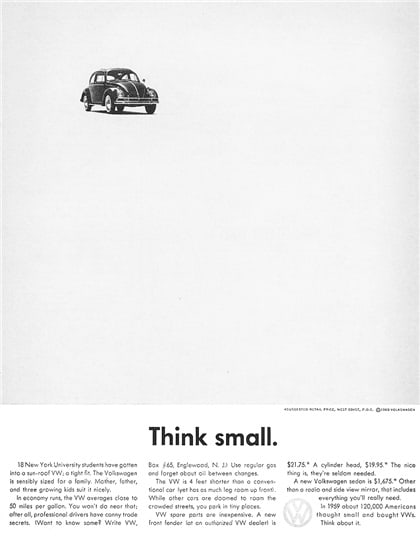Bill Bernbach, the prophet of inbound marketing
The concept of inbound marketing was not known until 2005 when this phrase was coined by HubSpot’s CEO, Brian Halligan. What exactly does it mean?
According to HubSpot in 2021, “inbound marketing is a business methodology that attracts customers by creating valuable content and experiences tailored to them. While outbound marketing interrupts your audience with content they don’t always want, inbound marketing forms connections they are looking for and solves problems they already have.”
So, where does a man named Bill Bernbach, born in 1911 and died in 1982, come into the picture? Bernbach was an American advertising creative in a period when outbound marketing reigned fiercer than ever before or after — because he decided to do it differently.
The concept of inbound marketing did not yet exist, nor was the methods and tools available, but his way of thinking was very much ‘inbound’. It was not the only way Bill Bernbach was an original and even a little stubborn: he hated research.
In 1947, he wrote to his boss at Grey Advertising, where he was creative director: “I’m worried that we’re going to worship techniques instead of substance. Advertising is fundamentally persuasion, and persuasion happens to be not a science, but an art.” Not long after, he packed up and started his own agency, Doyle Dane Bernbach.
How would he have done in the digital age, where everything starts with data?
We must assume that even Bill Bernbach would come to a more nuanced view in our day. But I think he would eventually have stuck to his belief: “We don’t ask research to do what it was never meant to do, and that is to get an idea.”
What he didn’t believe in is also not so relevant. More significant is what he did believe in and what he continues to inspire us with to this day.
To appreciate Bernbach’s significance, you have to see him in his era, the 1950s, ’60s, and ’70s. Television was in its infancy, and the internet was something nobody could even dream about or fathom. It was the golden era of advertising when the tendency was mainly ‘big and full’. A lot of ego from advertisers and agencies, ads that were stuffed with text and visual devices. A one-dimensional foot-in-the-door approach that now seems naïve.
Think different

We’re in 1959. Doyle Dane Bernbach has acquired Volkswagen as a client, and Bill Bernbach faces the task of selling “a Nazi car in a Jewish town.” In a market where 70% of the American car advertisements in that year contained illustrations which made the oversized vehicles just that little bit longer, lower and more powerful, Bernbach treated the world to a largely blank page, with a self-effacing mugshot of the unpretentious vehicle in the top left corner. And where Oldsmobile headlined: “You’ve got to drive it to believe it!” and Chevrolet: “Filled with grace and great new things”, Bernbach told the reader, “Think small.”
And then the body copy. A few lines at the bottom of the page lightly chatter about the benefits of small. A polished text that makes you think I could have written it myself. But in 1959 America, this tone of voice was nothing short of revolutionary. The consumer was not used to being addressed as if they were an adult and could make their own choices.
Bill Bernbach’s great credit is that he showed respect for the customer, simplicity, realism, relevance and proved that quiet humor can have a better sales result than the ad-style advertising to which the world was accustomed.
If a digital Bernbach were to arise now, how would we recognize them? It would not be someone who does something better than everyone else, but someone who does things fundamentally differently than others. And with such success that we are all going to do the same.
In anticipation of the arrival of the new Bernbach, here are some quotes from the original. They seem to me good travel companions in the daily changing communication landscape, in which we are all looking for the right path.
Everywhere where Bill Bernbach says ‘advertising’ you can also read ‘content marketing’.
“Let us prove to the world that good taste, good art, and good writing can be good selling.”
“Forget words like ‘hard sell’ and ‘soft sell.’ That will only confuse you. Just be sure your advertising is saying something with substance, something that will inform and serve the consumer, and be sure you’re saying it like it’s never been said before.”
“The most powerful element in advertising is the truth”.
“The truth isn’t the truth until people believe you.”
“There is practically nothing that is not capable of boring us.”
“We are so busy listening to statistics we forget we can create them.”
“Word of mouth is the best medium of all.”
“I don’t want people who do the right things. I want people who do inspiring things.”
“The most important element in success in ad writing is the product itself. […] That’s why we as an agency work so closely with the client on his product looking for improvements, looking for ways to make people want it, looking for changes in the product. Because when you have that, you are giving the people something that they can’t get elsewhere. And that is fundamentally what sells.”
“Be provocative. But be sure your provocativeness stems from your product.”
“Knowledge is ultimately available to everyone. Only true intuition, jumping from knowledge to an idea, is yours and yours alone.”
“All of us who professionally use the mass media are the shapers of society. We can vulgarize that society. We can brutalize it. Or we can help lift it onto a higher level.”
For more inspiration outside the box, read Content lessons from literary writers.
